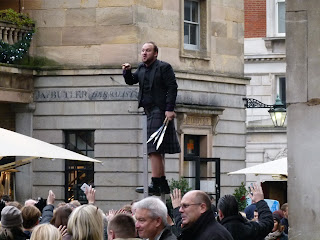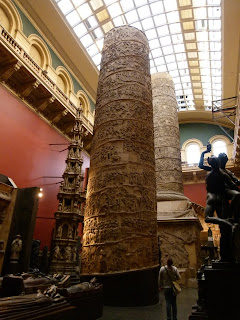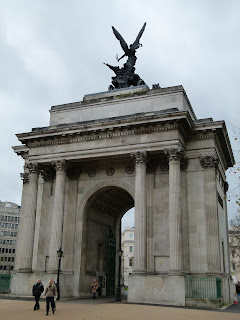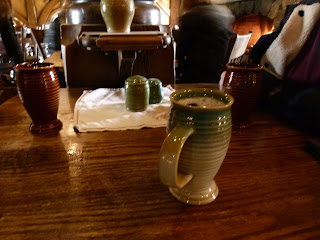So you're only in London for a day and you want to see as much as you can without running around. What should you see and do? I spent a day traipsing round London with my sister doing the following and we reckon these are some of the best bits of the city. We did this route in reverse on a Sunday, skipping the Natural History Museum because of the massive queue at 10am (opening time). Even missing that out, we were done by just gone 3pm.
Before we start, you're going to need comfortable shoes and you won't want to be carrying a heavy bag around with you. There's a fair bit of walking involved.
Start your day with a history and culture fix at the British Museum (nearest Tube Station: Russell Square or Holborn). It is entirely possible to spend the whole day in here (this is a recurring theme with London museums) so we've picked out some highlights for you. Start off by popping up to level 1 and seeing the Lewis Chessmen and the Sutton Hoo treasures. Beautifully crafted, they are. Then head down through the early Britain and Persian galleries and turn left into the Egyptian galleries. It's always busy in here, but if mummies are your thing, it's worth it. After that, head down the East Stairs, cross the courtyard and aim for room 21 where you can see fragments of the tomb of Mausolos, one of the Seven Wonders of the Ancient World. Follow the galleries through here to see some amazing pieces of Assyrian sculpture. This is the sort of stuff a certain terrorist group are currently blowing up in the Middle East, so make the most of it. More suggestions for the British Museum can be found in
THIS POST.
 |
| Treasure from the Sutton Hoo burial |
Once you've got your fill of history, take a walk south to Covent Garden. This takes about 15 minutes. Or you could take the shorter walk to Holborn Tube Station and hop on the Piccadilly Line to Covent Garden Station. Have a wander round the little shops and check out the street entertainment - it's normally pretty good round here.
 |
| In a kilt. Up a ladder. With knives. Covent Garden entertainment. |
Move on from Covent Garden towards Trafalgar Square, another 10 minute walk. Or take the Tube (various options) to Charing Cross. Trafalgar Square's great for people watching, so make sure to spend a few minutes enjoying the view and then pop into the National Portrait Gallery, just round the corner from the National Gallery which fronts onto the Square.
Portraiture isn't really my thing, but the Tudor and Stuart galleries are pretty interesting and probably the only thing I'd personally take in. From there, move on to the National Gallery. Plenty of amazing artwork to go at in here. The majority of the collection is on level 2 - just go straight up the stairs as you come through the main entrance at Trafalgar Square. Take in Van Gogh, Suerat and Monet (rooms 43-45), Caneletto (room 38), Turner's beautiful seascapes (my favourites, in room 34) and Rembrandt (rooms 23-4).
You might be getting a bit peckish by now. There's plenty of cafes around the Square, but I would suggest if it's a reasonable day, grab something to go and sit by the fountains to eat. Again, great for people watching.
From there, hop on the Tube from Charing Cross to Westminster (via Embankment). At Westminster, take a stroll onto the bridge to get those classic shots of Big Ben and the London Eye and then head north past the Houses of Parliament to see Westminster Abbey. It currently costs £20 to get into the Abbey, a price I'm not quite willing to pay, but do have a look inside if you can - I hear it's beautiful.
Carry on walking up Birdcage Walk. This will take you up alongside St James' Park and up to Buckingham Palace. It is always busy round here, but especially so at the Changing of the Guards. Take those selfies (or whatever it is people do at Buckingham Palace) and then head across the roundabout to take the road up past Green Park. If you're a bit lost, look for signs for Hyde Park Corner. At the top of the hill is the huge Wellington Arch.
If all that sounds like too much walking - it's about 30 minutes altogether - and you're not too bothered about Buckingham Palace, hop back on the Tube at Westminster and take the District or Circle lines to South Kensington. If you've done the walking, take the Piccadilly from Hyde Park Corner to South Kensington.
During the holidays and weekends, this must be one of the busiest stations on the Tube network and it's because some of London's most popular museums are accessed from it. We're suggesting the Victoria & Albert Museum as your first stop here, purely because the Natural History Museum is best left till late in the day.
So, head up the subway from the station and head into the V&A. Again, you could spend most of the day in here, so we've picked out some highlights. First, the costume gallery (room 40), to the right hand side if you enter through the Exhibition Road doors - a great view of how fashions have changed over the last few hundred years. This will lead you into the Asian galleries. We'll come back to this in a bit, but first head straight across into room 48a to see the amazing Raphael Cartoons - these are full size template drawings to be copied as tapestries. They're in amazing condition given their age. Once you've admired these, head back into the Asian galleries, making sure to check out the Islamic Middle East section (room 42) and from there go onto the Cast Courts (rooms 46a and 46b). These are full of various replicas, including a plaster copy of Trajan's Column.

History and art fix filled? Tired? Why not take a break in the V&A's awesome cafe. It gets busy, but if you've got time, it's worth it for the joy of eating in this room.
Awesome, right?
Anyway, head now up Exhibition Road away from the station. A 10 minute walk will bring you to the top where you need to turn left. You should see the Royal Albert Hall. Cross the road to get a better view of it and of the Albert Memorial which stands opposite. There's nothing to do here, just a nice view and we've tried to bring you to the Natural History Museum as late as possible.
On which note, we now need to head back down Exhibition Road, towards South Kensington Station. The Natural History Museum is on your right near the end of the road. Take the Exhibition Road entrance into the Earth Galleries. Take the escalator all the way up to the top floor and have a wander around the Volcanoes & Earthquakes area. Have a go on the Kobe earthquake simulator - great fun for kids (and adults, let's be honest).
 |
| Into the bowels of the Earth... |
Head back down to the ground floor and take a walk through the Green Zone. You should end up in a corridor full of fossil marine reptiles - one of my favourite parts of the museum. If you want to see the Natural History Museum's famous dinosaurs, now is the time. Cross the main entrance hall and enter the Dinosaur Gallery on your left. If it's late on in the day you should be able to enjoy the gallery at your own speed. If you've timed it wrong, you'll just get swept along in an irritable crowd.
The final suggestion I'd make for the Natural History Museum is the Darwin Centre. This is always quieter than the rest of the museum, but if you get creeped out by things floating in jars, it might not be for you. You've been warned.
That completes our suggestions for seeing London's highlights in a day. Obviously, these are just our ideas of what constitutes the highlights and I'd love to hear what others would include. Aside from the Tube, all the places included here are free entry. The Tube will be cheaper if you buy either a travelcard or get an Oyster Card. You'll also find getting on the Tube easier if you move down to the end of the platforms - the end carriages are quieter.
So, what do you think? What are your London highlights?















































